Let your eyes wander over the horizon… Which habitat do you think is the most favourable to biodiversity? The answer: ALL! The mosaic aspect of the landscape in front of you is a goldmine for biodiversity. Areas of bushes, scrubland, forest, shrubby hedges, lavender fields…
All of these environments constitute living habitats and ecological corridors that allow many species to move around, take refuge, rest and feed without risking increased predation or human disturbance. This mosaic is particularly beneficial to Bonelli’s eagle and the ocellated lizard, two species with a high
conservation value in the Ardèche.
Four species of theses environments
Bonelli’s eagle
Adults can be recognised in flight by their white bellies, spotted with black-brown flares and dark wings. In mainland France, the Bonelli’s eagle is considered to be in danger of extinction. It is protected at national level and is also included on the list of European priority species and in several international conventions.
In the Ardèche, we are lucky enough to have four known pairs. You can sometimes spot them flying over the campsite! Monitoring of these pairs has enabled us to estimate that their home ranges cover an area of around 50 km², although the individuals mainly travel within a 5 km radius of their nesting site. This bird of prey feeds mainly on birds. Its habitat consists of areas of Brachypodus scrubland, interspersed with limestone ranges and gorges.
Yellow Ophrys
This species of orchid can be recognised by its beautiful asymmetrical yellow flower and its velvety blue-grey or brown-mottled macula. It is found throughout the Mediterranean basin on limestone soils covered with lawns, fallow land, scrub or open woodland, as here at the campsite. Many species of orchid flower in spring at Briange, including the Bee Orchid, the Three-toed Orchid and the Burnt Orchid. Flowers from March to May.
Greater rhinolophus
The great rhinolophus is a large bat that hides in underground environments and in human infrastructures. In winter, it hibernates suspended from the ceiling of natural or artificial cavities, giving the impression of a small suspended bag. For reproduction, it uses cavities or buildings (attics, churches, cellars, etc.), forming colonies ranging from around twenty individuals to several hundred.
This bat is a lucifugous species (shuns light). It is therefore very sensitive to light pollution and is absent from urban areas. Its favourite food? Large prey, which it prefers to find on the edge of the forest, in the herbaceous layer and in bushes.
Did you know? The Great Rhinolophe’s short-range sonar means it flies close to vegetation and crosses roads at ground level. As a result, it is a regular victim of collisions with vehicles, particularly when roads cross hedgerows and rows of trees, which it uses as travel corridors.
Ocellated lizard
At 59 to 75 cm, the ocellated lizard is the largest lizard in mainland France. Despite this, it often goes unnoticed because it likes to hide. It frequents dry Mediterranean environments such as scrubland, maquis, dry grassland and vineyards. That’s why it’s endemic to the south of France!
Apart from its size, its distinctive colouring makes it impossible to mistake it for any other species. Its body, marbled with black, is covered with pale green scales. Its flanks have characteristic blue eye-spots. Despite an average lifespan of ten years, this species is classified as endangered in the Rhône-Alpes region. It has been protected in France since 2007.
Did you know? Beneficial insects are species that help agricultural production by predating pests or pollinating plants. 90% of them need a non-cultivated environment at some point in their life cycle: field margins, bushes, hedges, flowerbeds. Think about this if you use pesticides!
